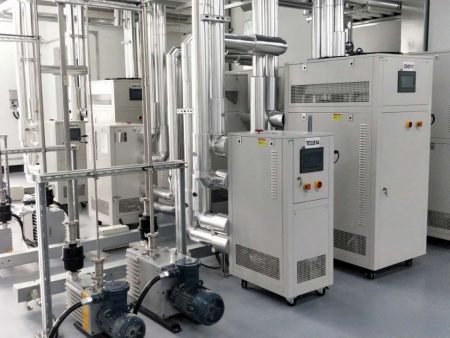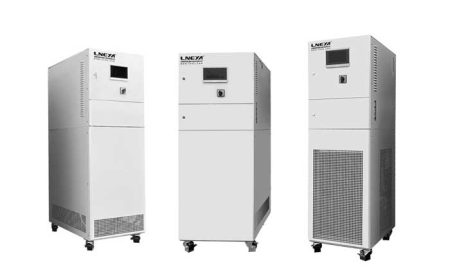Process Chilled Water System
A process chilled water system is a system used to control and regulate the transfer and release of heat in industrial processes. This system transfers water or other cooling media to the equipment or process that needs to be cooled, and transfers the heat generated in the equipment or process to the cooling medium to achieve cooling. Process chilled water system is widely used in electric power, chemical industry, pharmaceuticals, food processing, manufacturing and other fields. It can effectively ensure the normal operation of industrial processes, improve production efficiency and reduce production costs.
Generally speaking, process chilled water system includes cooling medium, cooling equipment, piping system and control system. The cooling medium is generally water or a mixture of water and other additives. Cooling equipment includes water cooling towers, water coolers, water pumps, etc., which can be selected and combined according to actual needs. The pipeline system is responsible for transporting the cooling medium to the equipment or process that requires cooling, and the control system ensures stable operation of the system by monitoring and adjusting parameters such as the temperature, flow rate, and pressure of the cooling medium.

Process chilled water system plays an important role in industrial production. First, it can reduce the temperature of equipment and processes and ensure the normal operation of equipment. In industrial production, many equipment need to work continuously for a long time and generate a large amount of heat. If it cannot be cooled in time, it will cause the equipment to overheat and malfunction, affecting production efficiency. Secondly, the process chilled water system can ensure the stability and consistency of the production process. Many industrial processes require specific temperature and humidity conditions, which requires fine control of the production environment. The process chilled water system can provide a stable temperature and humidity environment to ensure product quality and consistency. Finally, the process chilled water system can save energy and reduce production costs. By utilizing waste heat for thermal energy recovery and reuse, energy consumption during the production process can be reduced while reducing production costs.
It is important to note that there are many factors to consider in the design and operation of a process chilled water system. For example, different industrial processes require different cooling media and cooling equipment; parameters such as the flow rate and temperature of the cooling system need to be adjusted according to specific conditions; the pipeline system needs to be ensured to be smooth to prevent the water in the pipeline from flowing sluggishly or being blocked due to blockage. flow. During design, the diameter and length of the pipeline need to be reasonably selected, and the fluid pressure in the pipeline should be calculated based on the process flow and flow rate to ensure normal operation of the system.

In addition, when using process chilled water system, you need to pay attention to the following aspects:
Water quality: The quality of water directly affects the cooling effect and the life of the equipment. Therefore, it is necessary to regularly detect parameters such as water hardness, PH value, conductivity, etc., and adjust the water quality in a timely manner based on the test results.
Water circulation: Certain preservatives and bactericides need to be added during the water circulation process to prevent water tanks, water pipes, water pumps, etc. from being contaminated and affecting the cooling effect. Change the water quality regularly and clean the water tank and water pipes.
System stability: System stability is directly related to the stability and safety of the equipment. Therefore, it is necessary to fully consider the reliability of the system when designing and try to avoid pipe leaks, water pump failures, etc.
Energy consumption of the system: The process chilled water system requires a certain amount of energy, such as the operation of water pumps, cooling towers and other equipment that consumes electricity. Therefore, during the design and use process, it is necessary to optimize the energy efficiency of the system and minimize the waste of energy.
Process chilled water system is a commonly used industrial cooling technology that can provide necessary cooling guarantee for various industrial equipment and production processes. However, when using a process chilled water system, you need to pay attention to issues such as system design, water quality management, system stability, and energy consumption to ensure the normal operation of the system and the safety of the equipment.
Ofrecemos diseño y fabricación de sistemas completos de control de temperatura. Desde modelos estándar hasta productos personalizados completos de hasta 900 toneladas. Nos especializamos en el servicio al cliente y nos dedicamos a ayudar a cada cliente a tener el sistema de control de temperatura óptimo para su necesidad específica.
Ofrecemos soluciones personalizadas no estándar. Disponemos tanto de enfriadoras individuales como de unidades combinadas de refrigeración y calefacción.
Correo electrónico: info@lneya.com WeChat ID: +8615251628237 WhatsApp: +86 17851209193

Enfriadoras de recirculación / Criotermostatos
El enfriador puede utilizarse ampliamente en diversas industrias y laboratorios, y admite diseños personalizados.
| Temperatura | Serie -25°C ~ +30°C | Serie -45°C ~ +30°C | Serie -60°C ~ -20°C | Serie -80°C ~ -20°C | Serie -120°C ~ -70°C | ||||
| Capacidad de refrigeración | 0,8 ~ 30 kW | 0,75 ~ 12 kW | 0,4 ~ 6kW | 0,2 ~ 6kW | 0,3 ~ 5kW | ||||
| Nota: Se puede personalizar cualquier rango de temperatura de -150℃ ~ +350℃ y cualquier capacidad de refrigeración. | |||||||||
 Enfriadoras de agua / Enfriadoras pequeñas
Enfriadoras de agua / Enfriadoras pequeñas
El enfriador puede utilizarse ampliamente en diversas industrias y laboratorios, y admite diseños personalizados.
| Temperatura | -18°C ~ +30°C | Serie +5°C ~ +35°C | |||||||
| Capacidad de refrigeración | 0,35 ~ 0,9 kW | 1,8 ~ 50 kW | |||||||
| Nota: Se puede personalizar cualquier rango de temperatura de -150℃ ~ +350℃ y cualquier capacidad de refrigeración. | |||||||||

Refrigeradores de baja temperatura
Estamos especializados en la producción de refrigeradores de baja temperatura con un rango de control de temperatura de hasta -150°C, que pueden satisfacer las necesidades de refrigeración de diferentes industrias.
| Temperatura | Serie -25°C ~ -5°C | Serie -45°C ~ -10°C | Serie -60°C ~ -10°C | Serie -80°C ~ -30°C | Serie -110°C ~ -50°C | Serie -150°C ~ -110°C | |||
| Capacidad de refrigeración | 12 ~ 360 kW | 6 ~ 180 kW | 6 ~ 180 kW | 4 ~ 180kW | 2 ~ 120kW | 2,5 ~ 11 kW | |||
| Nota: Se puede personalizar cualquier rango de temperatura de -150℃ ~ +350℃ y cualquier capacidad de refrigeración. | |||||||||

Refrigeradores de alta temperatura
El enfriador puede utilizarse ampliamente en diversas industrias y laboratorios, y admite diseños personalizados.
| Temperatura | +5°C ~ +40°C | -25°C ~ +40°C | -45°C ~ +40°C | -80°C ~ +80°C | -100°C ~ +80°C | ||||
| Capacidad de refrigeración | 6 ~ 40kW | 2 ~ 15kW | 1 ~ 8kW | 0,6 ~ 3 kW | 1,5 ~ 3 kW | ||||
| Nota: Se puede personalizar cualquier rango de temperatura de -150℃ ~ +350℃ y cualquier capacidad de refrigeración. | |||||||||

Enfriadoras y calefactoras
Rango de control de temperatura: -120°C a +350°C
termostato de refrigeración y calefacción, ampliamente utilizado en diversas industrias.
| Temperatura | Serie -10 ~ +150°C | Serie -25 ~ +200°C | Serie -25 ~ +300°C | Serie -45 ~ +250°C | Serie -45 ~ +300°C | Serie -60 ~ +250°C | Serie -60 ~ +300°C | Serie -70 ~ +250°C | Serie -80 ~ +250°C | Serie -90 ~ +250°C | Serie -100 ~ +100°C | ||
| Capacidad de refrigeración | 1,5 ~ 15 kW | 1 ~ 200 kW | 1 ~ 200 kW | 0,45 ~ 200 kW | 0,9 ~ 25 kW | 0,25 ~ 60 kW | 0,75 ~ 25 kW | 0,4 ~ 15 kW | 0,3 ~ 80 kW | 0,2 ~ 80 kW | 0,45 ~ 80 kW | ||
| Nota: Se puede personalizar cualquier rango de temperatura de -150℃ ~ +350℃ y cualquier capacidad de refrigeración. | |||||||||||||

Enfriadoras de recirculación
Rango de control de temperatura: -45°C a +250°C
| Temperatura | Serie -25°C ~ +200°C | Serie -45°C ~ +250°C | |||||||
| Capacidad de refrigeración | 1 ~ 15 kW | 0,25 ~ 15 kW | |||||||
| Nota: Se puede personalizar cualquier rango de temperatura de -150℃ ~ +350℃ y cualquier capacidad de refrigeración. | |||||||||
 LNEYA
LNEYA
 简体中文
简体中文


















































































